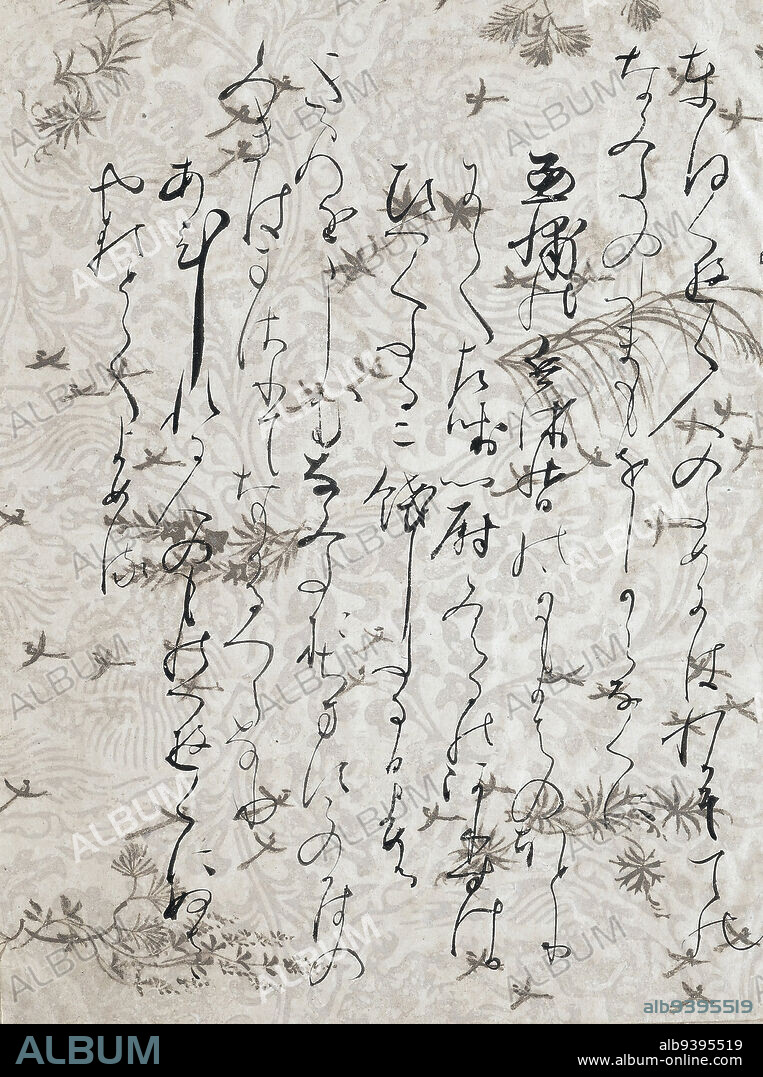alb9395519
Page from the Tsurayuki Anthology, vol. 2, known as Ishiyama-gire, 1112, attributed to Fujiwara Sadanobu, Japanese, 1088 - 1156, 7 15/16 × 6 5/16 in. (20.16 × 16.03 cm) (image)53 1/2 × 15 1/2 in. (135.89 × 39.37 cm) (mount, without roller ), Ink on assembled dyed paper decorated with silver and gold, Japan, 11th-12th century, This page is from volume two of the poems of Ki no Tsurayuki. This book and the poems of Lady Ise were the two volumes broken up early in the century to make the Ishiyama-gire fragments. This is the back side of a left page with lion rondels and vine motif printed in mica on white-coated paper. The grasses, branches and birds were drawn with a combination of gold and silver inks. The calligraphy is by Fujiwara no Sadanobu, the leading calligrapher of the late Heian period. His writing is swifter, bolder and more unconventional than that of the writer of the Ise Shu pages. We have examples of Sadanobu's style in writing Chinese characters in several fragments in the kohitsu tekagami Sokyo.

|
Añadir a otro lightbox |
|
Añadir a otro lightbox |



¿Ya tienes cuenta? Iniciar sesión
¿No tienes cuenta? Regístrate
Compra esta imagen

Descripción:
Ver traducción automática
Page from the Tsurayuki Anthology, vol. 2, known as Ishiyama-gire, 1112, attributed to Fujiwara Sadanobu, Japanese, 1088 - 1156, 7 15/16 × 6 5/16 in. (20.16 × 16.03 cm) (image)53 1/2 × 15 1/2 in. (135.89 × 39.37 cm) (mount, without roller ), Ink on assembled dyed paper decorated with silver and gold, Japan, 11th-12th century, This page is from volume two of the poems of Ki no Tsurayuki. This book and the poems of Lady Ise were the two volumes broken up early in the century to make the Ishiyama-gire fragments. This is the back side of a left page with lion rondels and vine motif printed in mica on white-coated paper. The grasses, branches and birds were drawn with a combination of gold and silver inks. The calligraphy is by Fujiwara no Sadanobu, the leading calligrapher of the late Heian period. His writing is swifter, bolder and more unconventional than that of the writer of the Ise Shu pages. We have examples of Sadanobu's style in writing Chinese characters in several fragments in the kohitsu tekagami Sokyo.
Personas:
Crédito:
Album / quintlox
Autorizaciones:
Modelo: No - Propiedad: No
¿Preguntas relacionadas con los derechos?
¿Preguntas relacionadas con los derechos?
Tamaño imagen:
2635 x 3535 px | 26.6 MB
Tamaño impresión:
22.3 x 29.9 cm | 8.8 x 11.8 in (300 dpi)
 Pinterest
Pinterest Twitter
Twitter Facebook
Facebook Copiar enlace
Copiar enlace Email
Email
